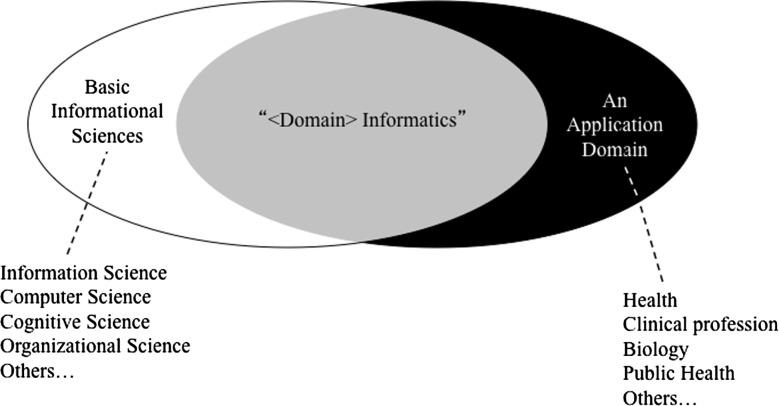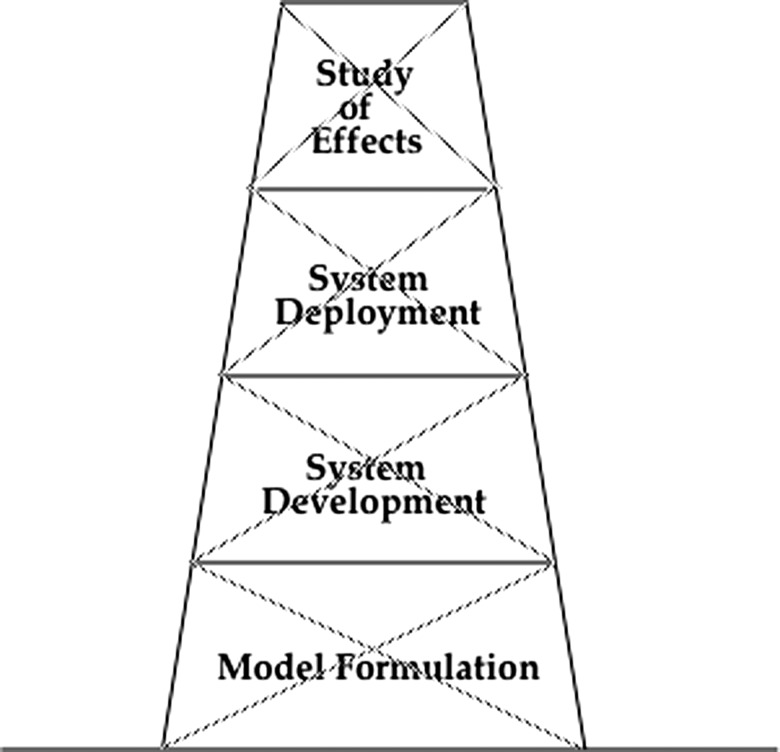Abstract
The term informatics is currently enveloped in chaos. One way to clarify the meaning of informatics is to identify the competencies associated with training in the field, but this approach can conceal the whole that the competencies atomistically describe. This work takes a different approach by offering three higher-level visions of what characterizes the field, viewing informatics as: (1) cross-training between basic informational sciences and an application domain, (2) the relentless pursuit of making people better at what they do, and (3) a field encompassing four related types of activities. Applying these perspectives to describe what informatics is, one can also conclude that informatics is not: tinkering with computers, analysis of large datasets per se, employment in circumscribed health IT workforce roles, the practice of health information management, or anything done using a computer.
Keywords: informatics, training, competencies, culture
An expanding cloud of chaos surrounds the word informatics. This cloud appears to have at least two major sources. The first is a proliferation of educational programs and organizations that, with various prefixes, use informatics in their titles. Once exclusively the province of graduate education, new educational programs calling themselves informatics have appeared at the baccalaureate degree level, including one at the University of Michigan.1 These new classes of programs have enrolled students with more diversified backgrounds than usual for informatics programs and have expanded the range of careers and levels of professional responsibility for which a degree in ‘informatics’ is seen as preparation. Second, the word informatics is being used casually in association with a broad range of activities and occupations that share only the use of a computer as a common element. A recent job report citing health informatics as a very rapidly growing field includes ‘medical records clerks’ and ‘coding compliance and review’ as health informatics career pathways.2 Expanding the cloud of chaos, a small number of ‘Schools of Informatics’ have appeared within institutions of higher education. And the accreditation organization formerly known as ‘CAHIM’ (Council on Accreditation for Health Information Management) has added a second ‘I’ to its name and now, as ‘CAHIIM’ (Council on Accreditation for Health Informatics and Information Management), is seeking to expand its portfolio to include health informatics programs in addition to health information management programs. This has brought informatics into semantic orbit around the profession of health information management.
These chaotic times should mobilize the community that has considered medical/biomedical/health informatics as its professional home for several decades to offer a compelling affirmative statement of what the field of informatics actually is. The signal originating from this effort may be lost amidst the rapidly rising level of noise in the environment, but there remains a solemn obligation to try. One way to articulate the nature of informatics is through defining a set of competencies such as those recently described in this journal,3 as a complement to several important works that have addressed this topic over many years.4–7 Competencies have the virtue of specificity, but they are statements at the atomic level; and in a dynamic field, they are ever-changing. Because they atomize the field, competencies can conceal what they add up to. So it can be challenging for competencies to make an enduring and consistent defining statement.
Another way is to approach the problem at a higher level, offering more generalized descriptions of the field, using metaphors to stimulate the imagination and create a gestalt sense of the field and the culture around it. This essay offers three such images of informatics below.
Informatics as cross-training
As illustrated in figure 1, informatics may be seen as the location in discipline space where (1) a particular set of relevant basic sciences meets (2) an application domain that is typically a field of professional practice. Using a crude analogy to elementary particle physics, informatics does not exist until these sciences and an application domain interact. It follows that persons educated in informatics are cross-trained. They have knowledge related to the basic sciences and knowledge of the practice domain. Sciences basic to informatics include, but are not limited to: information science, computer science, cognitive science, and organizational science. Education in informatics will, to some extent, address all four of these sciences. In a naming convention that has evolved over the years, the application domain creates the prefix for a particular branch of informatics. So cross-training between the relevant basic sciences and the domain of medicine gives rise to ‘medical informatics.’
Figure 1.
Informatics as cross-training.
The cross-training image makes a compelling case for the value of informatics. While someone trained in informatics typically knows less about each basic science than someone fully trained in that science, and less about the application domain than a full-time practitioner in that domain, cross-training spawns unique forms of creative potential and problem-solving capability that grow out of the connections the mind establishes when different areas of knowledge are invoked simultaneously. Cross-training also enables communication with both the basic scientists and the full-time professionals, making it possible for the cross-trained person to promote important modes of collaboration. (Figure 1 is not meant to imply that persons cross-trained in informatics have, in total, less knowledge than those trained solely in a basic informational science or a health domain.)
The ‘fundamental theorem’
Another image of informatics is the relentless pursuit of assisting people, as they work to improve health through appropriate use of information technology, and conducting studies to determine whether the assistance has been successful. This image (figure 2) has been offered as the ‘fundamental theorem’ of informatics: that persons supported by information technology will be better than the same persons performing the same task unassisted.8 The fundamental theorem, which can be expressed symbolically as a simple inequality, offers a strong cultural statement by expressing core values shared by all persons in the field. By expressing the need to study how successful the pursuit has been, the theorem calls attention to the empirical aspect of the field. Finally, the theorem emphasizes how and why informatics is a field about people as much as it is about technology.
Figure 2.

The ‘fundamental theorem.’
The ‘tower of achievement’
A third image, seen in figure 3, frames informatics as touching all four steps in a sequence aligned with creating and evaluating an information system or resource: (1) model formulation, (2) system development, (3) system deployment, and (4) study of effects.9 Each step is seen as having a science underlying it. Using this image, comprehensive training in informatics is associated with understanding of and ability to apply the science underlying each step. The vertical metaphor of the tower calls attention to the way each step depends on the steps preceding it, much as the structural integrity of a tower requires the lower levels to be strong enough to support those above them, suggesting that complete training in informatics must to some degree address each level of the tower.
Figure 3.
The ‘tower of achievement.’
WHAT INFORMATICS ISN'T
While each of these three images is distinctive, they collectively paint a consistent picture of the field. Invoked separately or in combination, by asserting what informatics is, they enable strong statements about what informatics isn't. In day-to-day professional experience and in written documents, the term informatics is becoming inappropriately associated with each of the following activities. None of them meets the requirements of the three images previously presented.
So informatics isn't:
Scientists or clinicians tinkering with computers: ‘Tinkerers’ are wonderful and the world needs them. They have terrific ideas, but typically, because ‘tinkerers’ lack formal training in the basic informational sciences, what they develop is not scalable or usable by anyone other than the developer him/herself.
Analysis of large datasets per se: It has been said that all epidemiologists are informaticians because they carry out statistical analyses using information technology. Epidemiologists and others who perform large-scale analytics do vital research essential to public health, but they use information technology strictly as a tool. Invoking any of the three images above, what they do is not informatics.
Circumscribed roles related to deployment and configuration of electronic health records in pursuit of meaningful use: The workforce education program developed through the Office of the National Coordinator for Health IT envisioned 12 health IT workforce roles.10 11 Most of these roles—for example, configuration or technical support specialists—operate exclusively at one level of the ‘tower of achievement’ and, as such, do not meet the criteria advanced here to allow the label informatics to be attached to them. However, some members of the health IT workforce, such as chief medical and nursing information officers, if prepared for these roles with the requisite cross-training, would certainly qualify as informaticians. It follows that, depending on which workforce roles they address and whether they provide requisite cross-training, programs to train the health IT workforce may or may not be training programs in informatics.
The profession of health information management: This important profession evolved from the profession of medical records management. It is a profession, in and of itself, with its own culture. Rank and file health information management professionals are informed users of technology but not scientifically-trained developers or explorers of its consequences. It follows that educational programs preparing students for careers as health information management professionals are not educational programs in informatics.
Anything done using a computer: This increasingly frequent misuse of informatics almost requires no elaboration. It reflects the same fundamental confusion between a tool and a field of human endeavor.
This essay is, above all, a plea. Whether the reader agrees or not with these specific assertions about what informatics is and isn't, these statements will ideally stimulate a concerted effort to complement expressions of competencies with a high-level affirmative expression of our identity and core values.
Acknowledgments
The author thanks members of the AMIA Academic Forum for their comments and suggestions which have significantly enriched this essay.
Footnotes
Competing interests: None.
Provenance and peer review: Not commissioned; internally peer reviewed.
References
- 1. A description of the University Michigan undergraduate program in informatics can be found at: http://informatics.cms.si.umich.edu/ (accessed 6 Jul 2012)
- 2. Burning Glass Technologies and Jobs for the Future. A Growing Jobs Sector: Health Informatics. June, 2012. http://www.jff.org/sites/default/files/CTW_burning_glass_publication_052912.pdf (accessed 6 July 2012)
- 3.Kulikowski CA, Shortliffe EH, Currie LM, et al. AMIA Board white paper: definition of biomedical informatics and specification of core competencies for graduate education in the discipline. JAMIA 2012;19:931–8. [DOI] [PMC free article] [PubMed] [Google Scholar]
- 4.Greenes RA, Shortliffe EH. Medical informatics: An emerging academic discipline and institutional priority. JAMA 1990;263:1114–20 [DOI] [PubMed] [Google Scholar]
- 5.Hersh W. A stimulus to define informatics and health information technology. BMC Med Inform Decis Mak 2009;9:24. [DOI] [PMC free article] [PubMed] [Google Scholar]
- 6.Bernstam EV, Smith JW, Johnson TR, et al. What is biomedical informatics? J Biomed Inform 2010;43:104–10 [DOI] [PMC free article] [PubMed] [Google Scholar]
- 7.Geissbuhler A, Kimura M, Kulikowski CA, et al. Confluence of disciplines in health informatics: an international perspective. Meth Inf Med 201;50:545–55 [DOI] [PubMed] [Google Scholar]
- 8.Friedman CP. A ‘fundamental theorem’ of biomedical informatics. JAMIA 2009;16:169–70 [DOI] [PMC free article] [PubMed] [Google Scholar]
- 9.Friedman CP. Where's the science in medical informatics? JAMIA 1995;2:65–7 [DOI] [PMC free article] [PubMed] [Google Scholar]
- 10. http://healthit.hhs.gov/portal/server.pt/community/healthit_hhs_gov__workforce_development_program/3659 (accessed 6 July 2012)
- 11.Hersh W. The health information technology workforce: Estimations of demands and a framework for requirements. Appl Clin Inf 2010;1:197–212 [DOI] [PMC free article] [PubMed] [Google Scholar]




